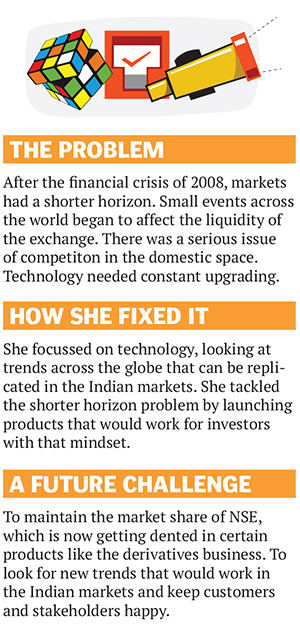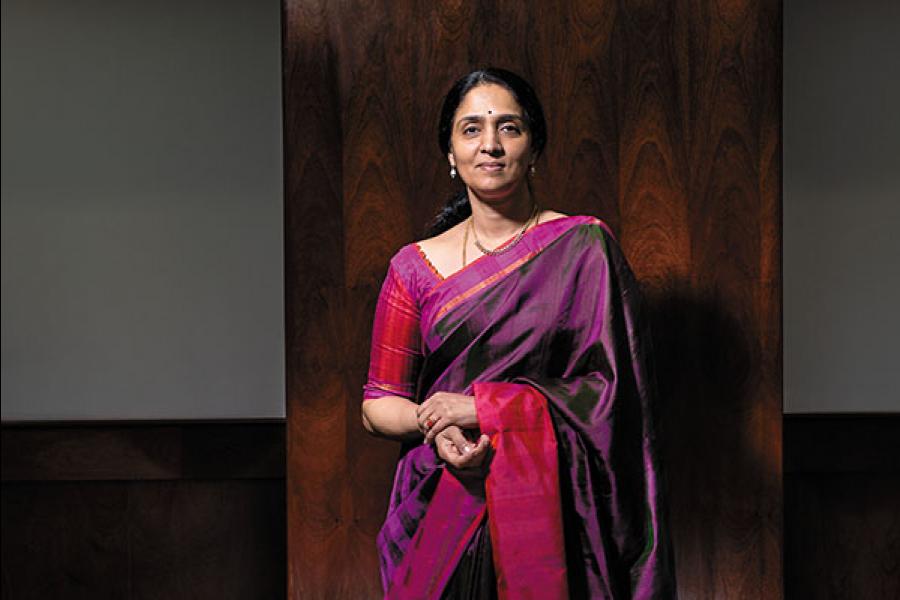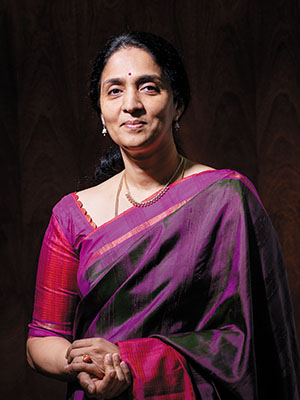
Chitra Ramkrishna: Queen of the Bourse
Starting from scratch in 1992, Chitra Ramkrishna helped set up the country's largest bourse, the National Stock Exchange. As its newest MD and CEO, she is looking to build on that success
Award: Women Leader of the Year
Chitra Ramkrishna
CEO & MD, National Stock Exchange
Age: 5O
Interests outside of work: Carnatic music; likes to play the veena
Why she won this award: For striking a delicate balance between the exchange’s commercial and regulatory roles and keeping NSE ahead of the pack with a high degree of professionalism, new
products and cutting-edge technology.
For someone who has never invested in equities, running the country’s largest stock exchange is as paradoxical as it gets.
But Chitra Ramkrishna, the 50-year-old managing director and CEO of National Stock Exchange (NSE), has always been comfortable with new challenges. Starting out as a chartered accountant, her first brush with finance came in 1985 when she joined the project finance division of Industrial Development Bank of India (IDBI). Ramkrishna then had a stint at Securities and Exchange Board of India (SEBI) and returned to IDBI two years later. It was here that she honed her financial skills, working at the treasury and fixed income departments before coming into her own while marketing the trendsetting deep discount bonds.
Her talent was such that the late RH Patil, executive director of IDBI at the time, complimented the young Ramkrishna for her extraordinary work and her role in making the bond issue a success. “In a public sector organisation, a senior manager rarely had a conversation with his junior. What Dr Patil did was completely unheard of. I was inspired and motivated to push myself further. Dr Patil was a visionary and a thinker and never seeded any doubts in our minds,” Ramkrishna says of the man who is widely credited with creating NSE.
Not surprising, she soon found herself as one of the five handpicked by the late SS Nadkarni, who was then IDBI chairman, to set up NSE from scratch and create a counterforce to the powerful Bombay Stock Exchange (BSE), which was then seen to be a closed club of brokers resistant to change.
The foundation stone
When Ramkrishna started her new assignment, she knew little about the business of bourses. Worse, the year was 1992 and Indian markets had gone through a bruising scandal, thanks to rogue trader Harshad Mehta. Brokers had become a tainted community and a new stock exchange was going to be up against a perception problem.
The government was keen to set up a stock exchange that would not have any of the problems witnessed by BSE, and would be seen as a professionally run bourse. The idea was to have a bourse that would conduct trading transparently and where price discovery would be clear and electronically driven. It was a tough ask.
The broking community too viewed NSE with some suspicion. When it was being set up, the brokers saw Ramkrishna as part of a team of bureaucrats who were trying to set up an institution that would never become a reality. What they had not reckoned with was the vision and determination of Nadkarni and Patil, which allowed the people on the job to execute the task independently.
Ramkrishna recalls a day when Nadkarni came to NSE’s office at Mahindra Towers in Mumbai’s Worli area to check on the progress. Those were the days of poor telephone connectivity; the BSE conducted trading under the open outcry system, where brokers would talk to each other and transact on the trading floor. If NSE was to take on the might of BSE, it would have to be with the help of satellite-based technology.
When asked by Nadkarni on when the exchange would be up and running, the team responded immediately: “In a few months.” Nadkarni was probably sceptical. But within just a few months, the NSE was functional. This drive set the benchmark for NSE and defined its culture, Ramkrishna says. She calls it “quick to market”. And, over the years, she developed a skill in execution that helped her build a reputation among the broking community.
Taking charge
Over 20 years later, on April 1, 2013, Ramkrishna took over at the corner room of the exchange she helped create, as its MD and CEO. This was a role played to perfection by her two predecessors—mentor and friend Ravi Narain, who led the exchange for 12 years, and Patil before him. Both are credited with creating a successful, professionally run and transparent stock exchange that effectively changed the rules of the game in India’s capital market.
“The entire team worked under Mr Narain’s supervision and he played a major role in grooming and mentoring all of us,” she says.
Stepping into such illustrious shoes was no small achievement, but Ramkrishna views her task with trademark professionalism, almost like a project she has to complete successfully.
While many feel the going will be smooth for her, given the strong foundations of the bourse and the fact that competition from new exchanges has waned, Ramkrishna, who was deputy managing director for many years, is not complacent. “There will be competition and we will have to take it seriously. There are challenges on a continuous basis,” she says.
She feels the world has changed dramatically after the global financial crisis of 2008. The volatility of the market, she explains, is different today as against the pre-crisis days. She calls this the new norm where markets have a shorter horizon.
“Demutualisation [the transformation of an exchange from being member-owned to shareholder-owned] was the biggest change in the last 20 years. It was ahead of the curve. It allowed the introduction of new products, better market infrastructure and institutional stakeholders,” she says.
Ramkrishna is acutely aware of the legacy she has to carry forward, that of the biggest names in the world of financial markets. Remind her of this, and she smiles. “The success of the exchange needs to be attributed to many people,” she says.
Scorching growth
In a sense, Ramkrishna’s rise to the top mirrors the growth of the bourse itself. Consider the figures. In March 1995, the exchange had 135 companies and the daily average turnover for equities was hardly Rs 17 crore. But it took only a few years for the exchange to take off and chart a frenetic pace of growth. Today, it has 1,672 companies and the average daily turnover in the cash segment has moved up 44 percent annually over the last 18 years to Rs 12,179 crore.
But it is the derivatives space that has given the biggest push. Over the last 12 years since March 2001, NSE’s average daily turnover for derivatives is up by 122 percent annually to Rs 1.58 lakh crore. Today, NSE has a combined daily average turnover at Rs 1.71 lakh crore. The exchange has a market share of 85% in both the cash and derivatives segment. NSE’s combined average daily turnover is almost five times higher than BSE’s.
Feet on the ground
While the exchange has witnessed heady success, Ramkrishna is not swayed by it. Attribute that to her conservative South Indian upbringing, where the focus was firmly on education and learning Carnatic music. Ramkrishna was more interested in learning how to play the veena rather than understanding the complex workings of the financial markets.
Having her feet firmly on the ground has helped Ramkrishna cope with the demands of her job. Says Motilal Oswal, chairman and managing director of Motilal Oswal Financial Services: “Chitra is focussed. She is totally grounded and values relationships. She is a great listener and notes down suggestions and immediately responds to customers.”
Oswal credits technology, strategy and the quality of people as factors propelling NSE’s win at the stock exchange sweepstakes. Ramkrishna, he says, has strong execution capabilities that helped the exchange in the initial stages.
The conservative, professional approach has defined some of the key decisions taken by the exchange. When NSE started, the board had a discussion about the need to give employee stock options to the management team. After a lengthy internal debate, the management decided against it because the exchange had a mixed role, both commercial and regulatory. Giving ESOPs to employees would dilute that and make profits an overriding motive. Maintaining a balance between the objectives was critical for NSE. If in the course of conducting orderly business, the exchange became profitable, that was a welcome by-product.
And profitable it is. For the financial year 2013, the exchange had a total income of Rs 1,283 crore with a net profit of Rs 842 crore. What is even more interesting is that it generates a high return on equity at 16 percent, compared to 5 percent for the BSE. Though there is no conscious effort to drive profits by sacrificing regulations, NSE now has active shareholders, including the likes of Goldman Sachs, General Atlantic and the New York Stock Exchange, who will be looking for returns.
“NSE is a curious amalgam, therefore a leader has to be clear that the exchange is strong on both regulation and commercial business. These can often be seen as conflicting with each other,” says Narain. “A leader needs complete clarity on how to handle this. Chitra is one of the few people I know who can do it without any conflict.”
Focussed and futuristic
Ramkrishna started internet trading at NSE in February 2000 when the market was at the peak of the dotcom boom. Though the market crashed later, NSE kept launching new products, including index and stock derivatives, setting benchmarks along the way. It was keen to take on products that were completely new to the Indian markets but had evolved and garnered traction internationally. As the exchange notched up new firsts, the Indian broking community, which had greeted the NSE’s idea with scepticism in the initial days, was impressed by the fact that the exchange managed to successfully take on BSE’s open outcry system and became successful in record time.
As an exchange administrator, Ramkrishna’s eye for global trends is well-known. When Sanjeev Shah, executive director of Benchmark Mutual Fund, approached NSE in November 2000 to talk about exchange traded funds (ETF), the first meeting was enough to convince him that the idea would find acceptance within the bourse management. Not only did Shah get approval for his ETF, it was up and trading by January 2002.

As the head of what is the country’s largest bourse, Ramkrishna knows that she must regularly be in touch with all her teams so that her objective of continually producing new, investor-friendly offerings keeps the exchange on top.
Inside NSE, she is known as tough and single-minded. She fosters team spirit and maintains a healthy balance between control and freedom. More importantly, she sees to it that performance is rewarded. NSE insiders say she is a visionary and knows what needs to be done over a period of time so that energy levels at the exchange are maintained.
Narain, now the non-executive vice chairman at NSE, has high praise for Ramkrishna’s leadership qualities: “What made her stand out is her passion and commitment, and her ability to understand complex issues which have the potential to transform the securities market. Besides, she did not have any baggage about what an exchange should be and that helped a lot.”
Having firmly established itself on Indian soil, the NSE management is aware that it must stay in the hunt for new opportunities. But instead of acquiring stock exchanges outside India, Ramkrishna wants to concentrate on the domestic space and believes ‘the action’ in the stock exchange business is concentrated in Asia.
Though mergers and acquisitions (M&A) have been a common trend among bourses globally since 2006-07, Ramkrishna has preferred to stay away from that game because Asian bourses are still growing.
However, that does not mean NSE is not going international. Ramkrishna has been able to push revenues across the border by exporting the Nifty ETF and other index derivative products, which now trade in 32 different destinations on international stock exchanges.
Fast forward
For NSE, the future will be driven by technology, and that is one area Ramkrishna is monitoring on a daily basis.
“After all, technology is the backbone of any exchange and we always keep an eye on international exchanges as far as this space is concerned,” she says.
Across the world, exchanges are becoming more nimble. Speed determines the quality and service an exchange offers as part of its high-end services. Algorithmic or automated trading is increasing as well.
NSE currently processes around 1.6 lakh orders per second, which makes it one of the fastest exchanges and allows for horizontal scaling (it is akin to adding new lanes to a highway based on the increase in traffic). Ramkrishna believes it is a process that is always evolving. “We do try to innovate in terms of technology. We look for ideas that seem likely to become a trend,” she says.
However, the focus on technology is not without an equal, almost obsessive, accent on quality as well. That is probably the reason the exchange has only 1,672 companies listed compared with BSE’s 5,000-plus. For the same reason, when NSE decided to list small and medium enterprises (SMEs), it took in only quality companies that are likely to become mainstream players in the future.
But with the economy in a slump and markets turning unpredictable, it is not as if companies are lining up to list on exchanges these days. Although the JustDial initial public offer (IPO) created a buzz this May, the IPO market, over the past few years, has shrunk dramatically and there is a serious dearth of new listings.
More than this, it is the practice of firms selling stakes to private equity (PE) players, replacing stock exchange offerings, that Ramkrishna is watching keenly. Often, PE companies in developed markets also take listed companies private in order to turn them around.
Would this pose a challenge to bourses like NSE? Ramkrishna pauses and then says: “When private equity players have to exit they have to come to the exchange. So they have limited choice.”
Having weathered numerous challenges, the NSE boss knows there is a strategy for every situation. You just have to work at it.
(This story appears in the 01 November, 2013 issue of Forbes India. To visit our Archives, click here.)
-
 Mrs Ritu Varma
Mrs Ritu VarmaWe are proud that she done in her life I wants to meet you mam I want to see my sixteen year old girl like you mam I don\'t know good English
on Sep 22, 2014 -
 Mahesh Kaloouni
Mahesh KaloouniCongratulations for winning award, I saw madam in one presentation recently at PHD chamber Delhi .
on Nov 1, 2013 -
 Lavanya
LavanyaCongratulations way to go
on Oct 26, 2013 -
 Shila
ShilaSaw one of Ms. Ramakrishna\'s presentation in an international seminar but wasn\'t quite impressed. Investors in Indian capital markets have pulled out substantially. what is the utility of such performance if it ultimately fails to restore investor confidence. Soon there will be no retail investor, so no NSE, no BSE and no SEBI.
on Oct 26, 2013-
 Vijay
VijayIt seems you are jealous. Nobody is born with experience but people learn and excel on job. Your comment is very baseless and negative.
on Aug 8, 2016
-
-
 Hemantbhatia
HemantbhatiaWhat a plight, MD herself never invested in equity.No wonder they will never understand the problems of investors.
on Oct 26, 2013 -
 Dr.a.jagadeesh
Dr.a.jagadeeshCongratulations Madam for winning Women Leader of the Year Award. Dr.A.Jagadeesh Nellore(AP),India
on Oct 25, 2013
















